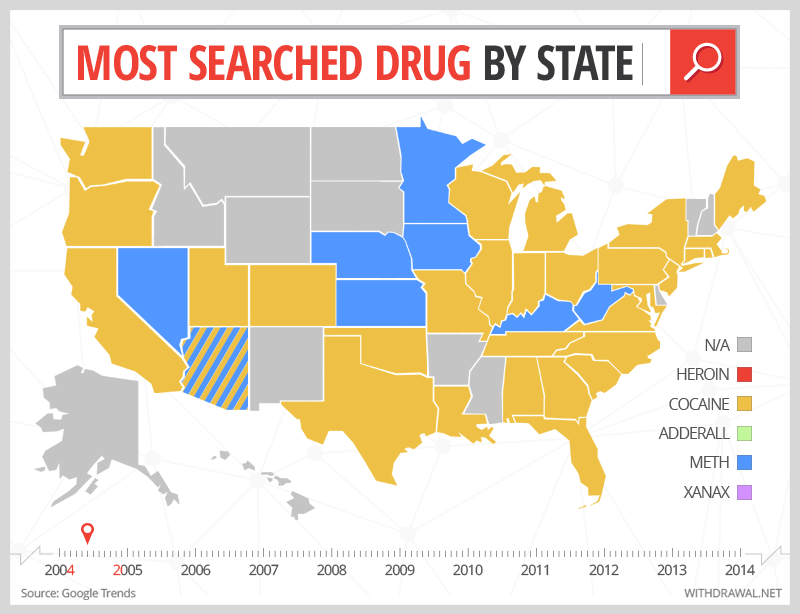Visualizing Drug-Related Web Searches Across the US
Trends in web searches have often been used to reveal the spikes and fluctuations of public interest in certain subjects – including taboo topics that aren’t frequently spoken about in person.
Many people aren’t comfortable openly discussing a personal interest in illicit substances, but they may have no problem anonymously entering the same substances into a web search box. We’ve examined trends in drug-related search terms throughout different states and major cities to reveal how a variety of illicit drugs have risen and fallen in popularity over the past decade.
It’s no secret that methamphetamine became one of the most commonly abused drugs in the 2000s. With a lower street price and a more intense high, meth rapidly surpassed cocaine as it swept across middle America.1, 2, 3 At the height of the meth epidemic in 2005–2006, it was the single most-searched drug in dozens of states.
Around the time meth became the subject of greater law enforcement attention and crackdowns, Adderall, a prescription stimulant, increasingly became a substance of abuse.4 Searches for the anxiety medication Xanax have also risen throughout the Midwest and South, at the same time that Xanax-related ER visits have doubled over six years.5
Many of the substances most frequently searched in major urban areas can be directly linked to recent events involving illicit drugs in those cities. It’s no coincidence that Washington and Virginia are sites of the most per capita searches for OxyContin, at a time when these regions are grappling with a surge in prescription opiate addiction.6, 7, 8 Per capita searches for cocaine are the highest in New York, where a massive cocaine distribution network was known to be operating.9
California has experienced a rise in new and dangerous forms of meth, becoming the leader in searches for the illicit stimulant.9 After Colorado legalized the recreational use of marijuana, Denver is now a hub of cannabis-related searches. In Pennsylvania, heroin has been described as an “epidemic.”10 And Massachusetts, where a doctor was indicted for illegally prescribing massive amounts of the opiate replacement medication Suboxone, shows the most searches for the drug.11
National trends in drug searches likewise reflect trends in illicit drug usage and popularity. After its 2005–2006 peak, interest in meth has once again soared as the drug continues to infiltrate American communities.12 And as addictive prescription painkillers have become more tightly regulated, heroin has become an increasingly popular substitute.13
Methodology & Fair Use
The information presented in this project comes from Google Trends, which tells users the relative popularity over time of searches for up to five different search phrases. While Google Trends gives a score for “interest over time,” which corresponds to search volume, it does not put units on this figure; this makes only relative and not absolute comparisons possible.
In the first image (animated .gif), we determined the most searched substance in each state for every month since January 2004 by limiting the view in Google Trends to that state, then manually recording which term or phrase with the highest score was for each month. For a number of months, not enough search volume occurred in certain states, causing that state to be labeled “N/A” for that month.
To identify the top cities for each search term in Google Trends, we looked at the “Regional Interest” section, filtered by city for each substance, and recorded the city with the highest regional interest score. Note that these scores are not based solely on the total search volume from that city, but rather reflect search volume per capita.
Withdrawal.net encourages the use of any of these results and the image assets found on this page. While the use of the images is encouraged, we ask that a link to Withdrawal.net and this page be included so that viewers may be fully aware of the methodology and have access to all assets and resources that are available.
Sources
1. http://www.jcsd.org/Meth.htm
2. http://www.pbs.org/wgbh/pages/frontline/meth/interviews/suo.html
3. http://www.wrbl.com/story/23343383/health-watch-adderall-abuse-is-on-the-rise
4. http://www.wkrn.com/story/25647731/doctors-say-abuse-of-xanax-on-the-rise
5. http://seattletimes.com/html/health/2004321621_oxycontinthefts02m.html
6. http://www.washingtonpost.com/wp-dyn/content/article/2008/01/12/AR2008011201181.html
7. http://www.nj.com/morris/index.ssf/2014/09/cops_16_arrested_in_cocaine_network_spanning_nj_and_nyc.html
8. http://www.laweekly.com/informer/2014/06/03/liquid-meth-floods-into-socal
9. http://thetimes-tribune.com/news/heroin-in-nepa-nothing-short-of-an-epidemic-1.1721821
10. http://www.mass.gov/ago/news-and-updates/press-releases/2013/2013-03-08-ng-indictment.html
11. http://www.utexas.edu/opa/blogs/research/2012/01/30/after-decrease-meth-use-rising-again/
12. http://www.tampabay.com/news/politics/stateroundup/after-pill-mill-crackdown-heroin-fills-a-void/2180122



